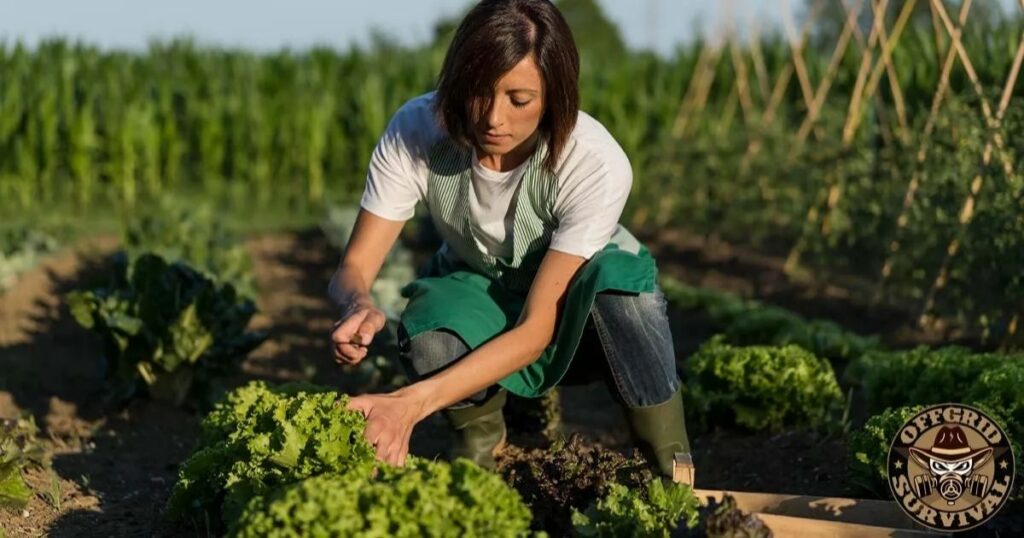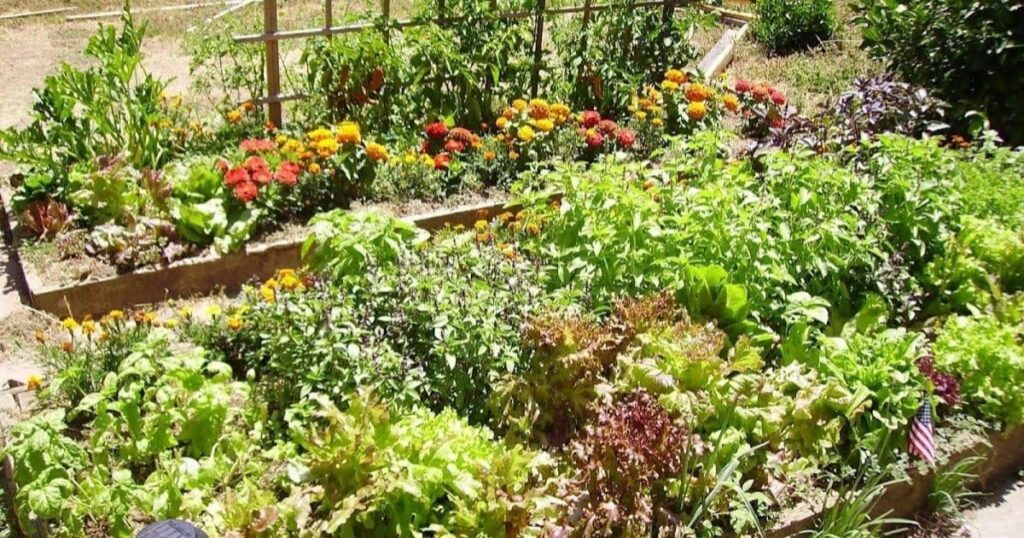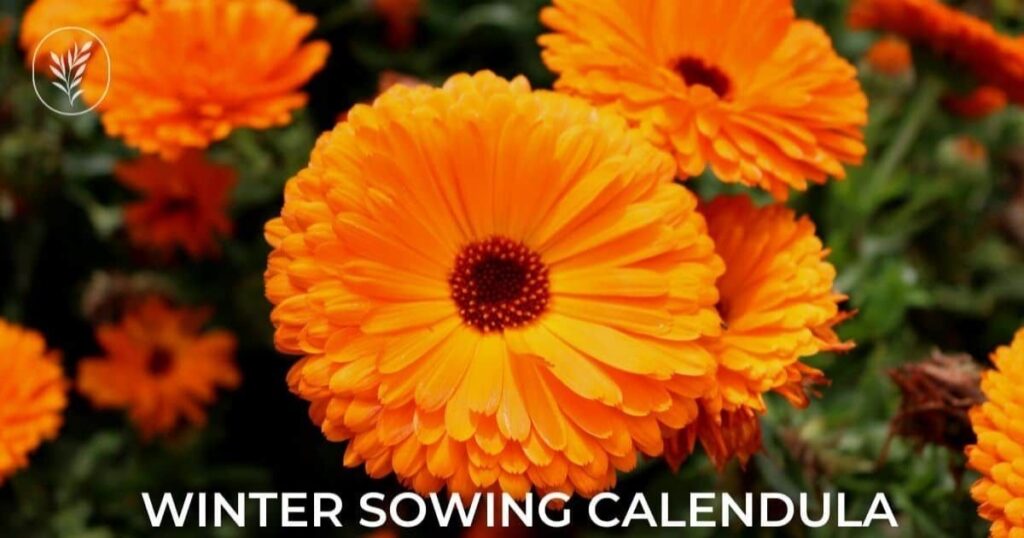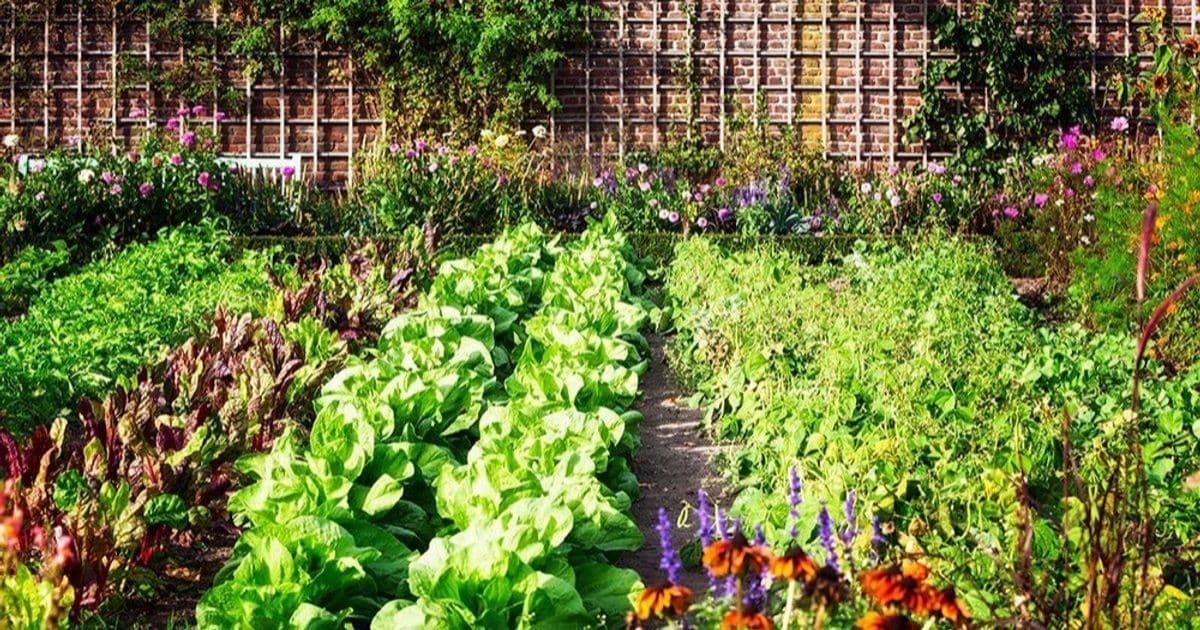Imagine your vegetable garden buzzing with life, where rows of veggies are interspersed with splashes of colorful annual flowers. It’s not just a feast for the eyes; it’s a smart gardening move, especially when it comes to attracting beneficial insects and bees. These friendly visitors are super important for your veggies to thrive, and in the summer, they’re all about visiting gardens like yours.
In this article, we’ll explore how mixing flowers with your vegetable plot can do wonders, making your garden not just look amazing but also work wonders for your plants. We’ll dive into the numerous benefits of planting flowers in vegetable gardens and introduce you to the top 10 flowers that can transform your vegetable patch into a thriving ecosystem.
Benefits of Planting Flowers in Vegetable Gardens
Before we delve into the specific flowers to plant, let’s explore the myriad benefits of incorporating flowers into your vegetable garden.
1. Enhancing Biodiversity
One of the primary advantages of planting flowers in your vegetable garden is the enhancement of biodiversity. By introducing a variety of plant species, you create a more diverse ecosystem that supports a wide range of life forms.
- Diverse Ecosystem: Incorporating a variety of flowers attracts different species of insects and birds, creating a more balanced and resilient garden ecosystem. This diversity helps maintain a natural equilibrium, preventing any single species from dominating and potentially causing damage to your crops.
- Natural Balance: The increased biodiversity helps maintain a natural balance in your garden. With a wider range of plants and insects present, the likelihood of pest outbreaks is reduced, as predators and prey exist in a more balanced relationship.
2. Attract Beneficial Insects
Flowers play a crucial role in attracting beneficial insects to your vegetable garden. These helpful creatures can significantly reduce pest problems and improve pollination.
- Natural Pest Control: Many flowers, such as marigolds and sweet alyssum, attract ladybugs, lacewings, and other predatory insects. These beneficial insects feed on common garden pests like aphids, helping to control their populations naturally without the need for chemical pesticides.
- Pollinators: Flowers are essential for attracting pollinators such as bees, butterflies, and hoverflies. These insects are crucial for the pollination of many vegetable crops, including tomatoes, squash, and peppers. By ensuring a steady presence of pollinators, you can improve fruit sets and overall yields in your vegetable garden.
3. Companion Planting Advantages

Companion planting is the practice of growing different plants together for mutual benefit. Flowers can be excellent companions for your vegetable plants.
- Pest Deterrent: Certain flowers emit scents or possess properties that deter specific pests. For example, marigolds are known to repel nematodes, while nasturtiums can deter aphids and whiteflies. By strategically planting these flowers near susceptible vegetables, you can create a natural form of pest control.
- Synergistic Growth: Some flower and vegetable pairings can enhance each other’s growth. For instance, borage is known to improve the growth and flavor of strawberries and tomatoes when planted nearby. These symbiotic relationships can lead to healthier plants and better yields.
4. Soil Health Improvement
Flowers can contribute significantly to improving and maintaining soil health in your vegetable garden.
Also read this post:Lavender Companion Plants
- Nutrient Contribution: As flowers grow, bloom, and eventually die back, they contribute organic matter to the soil. This decomposing plant material adds essential nutrients back to the soil, improving its fertility and structure over time.
- Root Systems: Different flowers have varied root systems that can help improve soil structure. Deep-rooted flowers like sunflowers can help break up compacted soil, while shallow-rooted flowers can prevent soil erosion. This diversity in root systems promotes better soil aeration and water retention.
5. Trap Cropping
Some flowers can serve as effective trap crops, drawing pests away from your valuable vegetables.
- Diverting Pests: Certain flowers can act as decoys, attracting pests away from your main vegetable crops. For example, nasturtiums are known to attract aphids, keeping them away from other plants. By strategically placing these trap crops, you can protect your vegetables while managing pest populations more effectively.
6. Enhanced Pollination
Flowers play a vital role in attracting pollinators, which are essential for many vegetable crops.
- Increased Crop Yield: With more pollinators visiting the garden due to the presence of flowers, there’s an increase in the pollination rates of vegetable plants. This often leads to higher yields and better-quality produce. Vegetables like tomatoes, peppers, squash, and cucumbers particularly benefit from increased pollinator activity.
Top 10 Flowers to Plant in Your Vegetable Garden

Now that we’ve explored the benefits of planting flowers in your vegetable garden, let’s dive into the top 10 flowers that can make a significant impact on your garden’s health and productivity.
1. Marigolds
Marigolds are a classic choice for vegetable gardens, and for good reason. These vibrant flowers offer multiple benefits that make them indispensable in any garden setting.
Benefits:
- Natural pest repellent, particularly effective against nematodes and harmful insects
- Attract beneficial insects like ladybugs and lacewings
- Enhance pollination by attracting bees and other pollinators
- Add visual appeal with bright, cheerful colors
- Can improve the growth of nearby plants
Planting Tips:
- Choose a sunny spot with at least 6 hours of direct sunlight daily
- Plant in well-drained soil
- Space plants 8 to 12 inches apart for proper air circulation
- Water regularly, keeping the soil moist but not waterlogged
- Deadhead spent blooms to encourage further flowering
- Plant after the last frost in spring
Marigolds are low-maintenance and adaptable, making them an excellent choice for both novice and experienced gardeners. Their pest-repelling properties and ability to attract beneficial insects make them a valuable addition to any vegetable garden.
2. Sweet Alyssum
Sweet Alyssum is a delicate, low-growing flower that packs a powerful punch in terms of garden benefits. Its dense clusters of tiny flowers create a carpet of bloom that’s as functional as it is beautiful.
Benefits:
- Attracts a wide range of beneficial insects, including predatory wasps and hoverflies
- Provides continuous nectar source for pollinators
- Acts as a living mulch, suppressing weeds and retaining soil moisture
- Adds aesthetic charm with its delicate, fragrant flowers
- Enhances biodiversity in the garden
Planting Tips:
- Plant in full to partial sun
- Prefers well-drained soil
- Space seedlings or seeds 6 to 8 inches apart
- Water regularly, especially during dry spells
- Low fertilizer needs; a light application at the beginning of the season is sufficient
- Self-seeds readily, often reappearing the following year
Sweet Alyssum’s ability to attract beneficial insects while suppressing weeds makes it an excellent choice for integrated pest management in vegetable gardens. Its low-growing habit allows it to be planted near taller vegetables without competing for light or nutrients.
3. Sunflowers
Sunflowers are more than just a cheerful addition to your garden; they offer numerous benefits that can enhance your vegetable-growing experience.
Benefits:
- Excellent at attracting bees and other pollinators
- Can serve as natural trellises for climbing plants like beans and cucumbers
- Act as a living privacy screen or windbreak
- Some varieties can extract toxins from the soil, improving overall soil health
- Provide seeds for birds and humans alike
Planting Tips:
- Plant in full sun, requiring at least 6-8 hours of direct sunlight daily
- Prefer well-drained, nutrient-rich soil
- Space plants 12 to 24 inches apart, depending on the variety
- Ensure soil is loose and well-tilled to accommodate deep roots
- Water regularly, especially during the growth and bloom phases
- Consider staking taller varieties to prevent toppling in strong winds
- Plant after the last frost, with some varieties maturing in 70 to 100 days
Sunflowers’ tall stature and ability to attract pollinators make them an excellent choice for the edges of vegetable gardens. They can provide shade for heat-sensitive plants while still allowing plenty of sunlight for sun-loving vegetables.
4. Cosmos
Cosmos are easy-to-grow flowers that add a whimsical touch to any vegetable garden while providing numerous benefits.
Benefits:
- Attract a variety of pollinators, including bees and butterflies
- Bring in beneficial insects that help control pest populations
- Provide light, dappled shade for lower-growing plants
- Easy to grow and low maintenance
- Excellent cut flowers for bouquets
Planting Tips:
- Plant in a sunny location with at least 6 hours of direct sunlight
- Tolerant of poor soil conditions
- Space plants 12 to 18 inches apart
- Drought-tolerant once established
- Benefit from occasional deadheading to encourage continuous blooming
- Can be directly seeded into the garden after the last frost
- Consider succession planting for continuous blooms throughout the season
Cosmos’ airy foliage and bright flowers make them an excellent companion for many vegetables. Their ability to attract pollinators and beneficial insects while requiring minimal care makes them a valuable addition to any vegetable garden.
5. Nasturtiums
Nasturtiums are versatile flowers that offer both beauty and functionality in the vegetable garden. Their edible flowers and leaves add an extra dimension to their usefulness.
Benefits:
- Attract beneficial insects while acting as a trap crop for pests like aphids and squash bugs
- Natural pest deterrent for many common garden pests
- Edible flowers and leaves with a spicy, peppery flavor
- Enhance biodiversity by attracting pollinators
- Add vibrant colors and lush foliage to the garden
Planting Tips:
- Can thrive in both full sun and partial shade
- Prefer well-drained soil; produce more flowers in poorer soils
- Space plants 10 to 12 inches apart
- Moderate watering; avoid overwatering to prevent root rot
- Low fertilizer needs; too much can lead to more foliage and fewer flowers
- Can be directly seeded into the garden after the last frost risk has passed
- Self-seed readily, providing continuous display year after year
Nasturtiums’ dual role as both a trap crop and a beneficial insect attractor makes them an excellent choice for integrated pest management in vegetable gardens. Their trailing habit makes them ideal for planting along the edges of raised beds or in hanging baskets near vegetable plants.
6. Zinnias
Zinnias are vibrant, easy-to-grow flowers that can add a burst of color to your vegetable garden while providing numerous benefits.
Benefits:
- Exceptional at attracting a wide array of pollinators, including bees, butterflies, and hummingbirds
- Attract beneficial insects that help control pest populations
- Enhance biodiversity in the garden
- Easy to grow and maintain, suitable for gardeners of all skill levels
- Provide long-lasting cut flowers for bouquets
Planting Tips:
- Require full sun exposure, at least 6 hours of direct sunlight daily
- Prefer rich, well-drained soil
- Space plants 6 to 18 inches apart, depending on the variety
- Regular watering is important, but avoid wetting the foliage to prevent fungal diseases
- Respond well to deadheading, which encourages more blooms
- Can be directly sown into the garden after the last frost date
- Fast growers, often blooming within 60 days of planting
Zinnias’ ability to attract a diverse range of pollinators makes them an excellent choice for improving the overall health and productivity of your vegetable garden. Their variety of colors and heights allows for creative garden designs that complement your vegetable plantings.
7. Calendula

Calendula, also known as pot marigold, is a versatile flower that offers both ornamental and practical benefits in the vegetable garden.
Benefits:
- Attracts beneficial insects like ladybugs and lacewings, aiding in natural pest control
- Edible flowers that can be used in salads and as a garnish
- Possesses medicinal properties, useful in homemade remedies
- Enhances overall garden ecosystem health
- Aids in pollination of vegetables
Planting Tips:
- Thrives in full to partial sun
- Adaptable to different soil types, prefers well-drained soil
- Space plants 8 to 12 inches apart
- Regular watering is important, especially in dry conditions
- Benefits from deadheading to promote continuous blooming
- Can be directly sown in spring after the last frost or in fall in milder climates
- A hardy plant that can withstand cooler temperatures, extending the flowering season
Calendula’s pest-deterring properties and ability to attract beneficial insects make it an excellent companion plant for many vegetables. Its edible flowers add an extra dimension of usefulness, allowing you to incorporate them into your culinary creations straight from the garden.
8. Borage
Borage is an herb with beautiful star-shaped blue flowers that offers multiple benefits to the vegetable garden.
Benefits:
- Excellent at attracting pollinators, especially bees
- Edible flowers with a mild cucumber-like flavor
- Companion planting benefits, particularly for tomatoes, squash, and strawberries
- Deep taproots bring up nutrients from deeper in the soil
- Improves soil quality and benefits surrounding plants
Planting Tips:
- Prefers sunny spots but can tolerate partial shade
- Thrives in well-drained soil
- Space plants 12 to 18 inches apart
- Drought-tolerant once established
- A self-seeding plant that can reappear year after year
- Can be directly sown into the garden after the danger of frost has passed
- Grows quickly and starts flowering within a few weeks of planting
Borage’s ability to attract pollinators and improve soil quality makes it an excellent addition to any vegetable garden. Its edible flowers can add a unique touch to summer salads and drinks, providing both beauty and functionality.
9. Lavender
Lavender is a fragrant perennial that offers numerous benefits to the vegetable garden beyond its aromatic qualities.
Benefits:
- Effective in deterring common garden pests like moths, deer, and rabbits
- Attracts pollinators such as bees and butterflies
- Creates a calming and soothing environment in the garden
- Has culinary, medicinal, and aromatherapy uses
- Adds visual interest with its silver-green foliage and purple blooms
Planting Tips:
- Requires full sun and well-drained slightly alkaline soil
- Space plants 18 to 24 inches apart for good air circulation
- Drought-tolerant once established; avoid overwatering
- Prune in early spring or after blooming to maintain shape
- Can be planted in spring or early fall
- Takes a few years to fully establish but is long-lasting once settled
Lavender’s pest-deterring properties and ability to attract pollinators make it an excellent companion plant for many vegetables. Its aromatic qualities can also help mask the scent of certain vegetables, potentially confusing pests and reducing damage to your crops.
10. Basil
While primarily known as a culinary herb, basil offers numerous benefits when planted in the vegetable garden.
Benefits:
- Repels pests, including mosquitoes and flies, with its strong scent
- Enhances the flavor of nearby tomatoes and peppers
- Attracts pollinators when allowed to flower
- Improves the overall health and vigor of neighboring plants
- Versatile culinary herb used in a wide range of dishes
Planting Tips:
- Thrives in warm conditions and requires full sun
- Prefers well-drained, fertile soil
- Space plants 10 to 12 inches apart
- Regular watering is important, especially during dry spells
- Sensitive to cold; plant after the risk of frost has passed
- Regular pinching back of tips encourages bushier growth
- Can be grown in garden beds or containers
Basil’s pest-repelling properties and ability to enhance the flavor of nearby vegetables make it an excellent companion plant, especially for tomatoes and peppers. Its culinary uses add an extra dimension of usefulness, allowing you to harvest fresh herbs while benefiting your vegetable plants.
In conclusion, incorporating these top 10 flowers into your vegetable garden can significantly enhance its health, productivity, and beauty. By attracting beneficial insects, repelling pests, improving soil health, and increasing biodiversity, these flowers work in harmony with your vegetables to create a thriving garden ecosystem.
Whether you’re a seasoned gardener or just starting, integrating these flowers into your vegetable patch can lead to a more balanced, productive, and enjoyable gardening experience. Remember to consider the specific needs of each flower and how they complement your vegetable plants when planning your garden layout. With the right combination of flowers and vegetables, you can create a vibrant, productive, and sustainable garden that benefits both you and the environment.
FAQs
What flowers are best for vegetable gardens?
The best flowers for vegetable gardens are those that attract beneficial insects, repel pests, or improve soil health. Some top choices include marigolds, nasturtiums, sunflowers, calendula, and sweet alyssum.
Which flower can be used as a vegetable?
Several flowers can be used as vegetables, with nasturtiums being a popular choice for their edible leaves and flowers. Calendula petals are also edible and can be used as a saffron substitute in cooking.
What are 4 types of flower vegetables?
Four types of flower vegetables are broccoli, cauliflower, artichokes, and squash blossoms. These plants are cultivated for their edible flower heads or buds, which are harvested before they fully bloom.
What are the best pollinator flowers for vegetable gardens?
The best pollinator flowers for vegetable gardens are those that attract a wide variety of bees, butterflies, and other beneficial insects. Some excellent choices include zinnias, cosmos, borage, and sunflowers, which provide ample nectar and pollen to support diverse pollinator populations.











